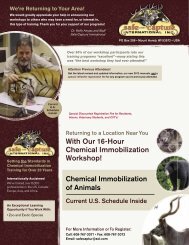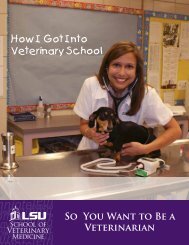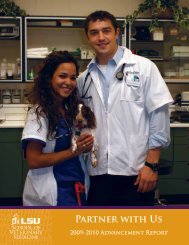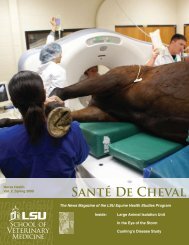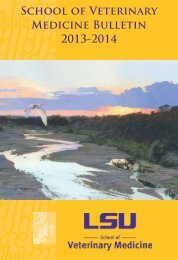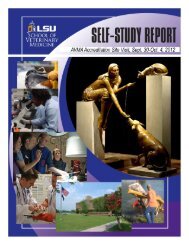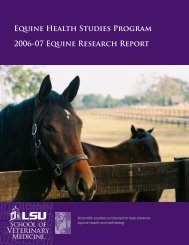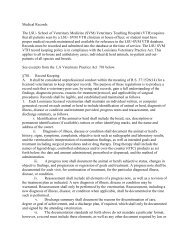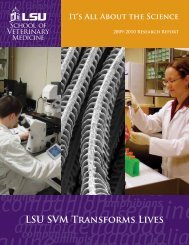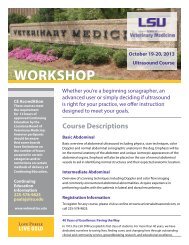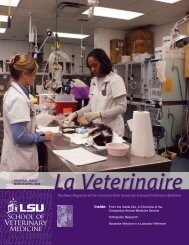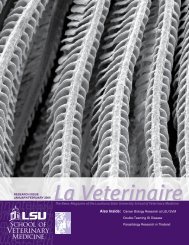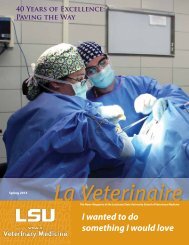Rockin' Round the Clock - School of Veterinary Medicine - Louisiana ...
Rockin' Round the Clock - School of Veterinary Medicine - Louisiana ...
Rockin' Round the Clock - School of Veterinary Medicine - Louisiana ...
You also want an ePaper? Increase the reach of your titles
YUMPU automatically turns print PDFs into web optimized ePapers that Google loves.
substituting for dopamine and<br />
inhibiting excessive cortical<br />
production from <strong>the</strong> pars<br />
intermedia <strong>of</strong> <strong>the</strong> pituitary<br />
gland.<br />
Horses in <strong>the</strong> study showed<br />
improved hair coat, more<br />
complete and timely shedding,<br />
increased muscle mass, and<br />
a better mental attitude. In<br />
addition, <strong>the</strong>re was less risk<br />
<strong>of</strong> developing laminitis and<br />
infections, such as sinusitis,<br />
pneumonia, and tooth root<br />
abscesses.<br />
These studies resulted in<br />
pergolide being accepted<br />
as <strong>the</strong> first Food & Drug Administration-approved drug for<br />
treatment <strong>of</strong> PPID in horses. Dr. Andrews also assisted BVIM<br />
in developing a website to educate clients and veterinarians<br />
about PPID (http://www.prascend.com).<br />
Dr. Andrews has performed many studies on <strong>the</strong><br />
pathogenesis, treatment, and prevention <strong>of</strong> equine gastric<br />
ulcer syndrome (EGUS). The anatomy <strong>of</strong> <strong>the</strong> equine stomach<br />
makes it uniquely predisposed to <strong>the</strong> formation <strong>of</strong> mucosal<br />
ulcers, which leads to poor performance, colic (abdominal<br />
pain), roughened hair coat, lack <strong>of</strong> appetite, and weight loss,<br />
a real problem in both weanling and performance horses.<br />
Recently <strong>the</strong>re has been considerable interest in <strong>the</strong> use <strong>of</strong><br />
plants, herbs, minerals and natural agents <strong>of</strong>fered as feed<br />
supplements to prevent EGUS and gastric ulceration in<br />
humans.<br />
Using a model where he can assess <strong>the</strong> impact <strong>of</strong><br />
supplements on gastric mucosal integrity, Dr. Andrews<br />
is currently investigating <strong>the</strong> efficacy <strong>of</strong> several feed<br />
supplements to prevent EGUS, including an extract <strong>of</strong><br />
Seabuckthorn berries (Hippophae rhamnoides) b and a<br />
combination <strong>of</strong> performance minerals and a gut-conditioning<br />
agent. c Initial studies <strong>of</strong> this latter product appear promising<br />
for <strong>the</strong> prevention <strong>of</strong> EGUS after initial treatment.<br />
ABOVE: Dr. Frank Andrews in <strong>the</strong> Charles V. Cusimano<br />
Equine Physiology and Pharmacology Laboratory.<br />
OPPOSITE PAGE: Seabuckthorn berries.<br />
To better understand gastrointestinal function, Dr. Andrews<br />
has been using a wireless capsule d gastrointestinal monitoring<br />
system that measures pH, temperature, pressure, and transit<br />
time after it is swallowed. As <strong>the</strong> capsule passes through <strong>the</strong><br />
gastrointestinal tract, it transmits data to a monitor attached<br />
to <strong>the</strong> patient. This allows an accurate and non-invasive<br />
estimation <strong>of</strong> gastric emptying time (<strong>the</strong> time required for food<br />
to pass through <strong>the</strong> stomach) and transit time through <strong>the</strong> rest<br />
<strong>of</strong> <strong>the</strong> gastrointestinal tract. Dr. Andrews found that <strong>the</strong> adult<br />
horse empties <strong>the</strong> stomach in approximately eight hours and<br />
it takes about 48 hours for material to traverse <strong>the</strong> entire 140<br />
feet <strong>of</strong> a horse’s intestines. Dr. Andrews believes that such<br />
a non-invasive model will allow him to assess <strong>the</strong> impact <strong>of</strong><br />
medications on gastrointestinal function and assist in <strong>the</strong><br />
diagnosis <strong>of</strong> diseases <strong>of</strong> <strong>the</strong> stomach and intestines that alter<br />
motility, such as duodenal strictures (narrowing) and colic.<br />
“By building relationships with industry, academic research<br />
institutions, such as LSU, can put into practice and explore<br />
<strong>the</strong> feasibility <strong>of</strong> cutting-edge technology and innovative<br />
medicines to diagnose and treat diseases affecting horses<br />
and o<strong>the</strong>r animals,” said Dr. Andrews.<br />
a Prascend ® , Boehringer Ingelheim Vetmedica, Inc., St.<br />
Joseph, MO 64506.<br />
b SeaBuck TM Complete and SeaBuck TM GastroPlus,<br />
Seabuck, Equine LLC, Midvale, VT 84047.<br />
c Egusin ® , Centaur, Inc., Overland Park, KS, 66225.<br />
d SmartPill ® , SmartPill Corporation, Buffalo, NY 14203.<br />
7



